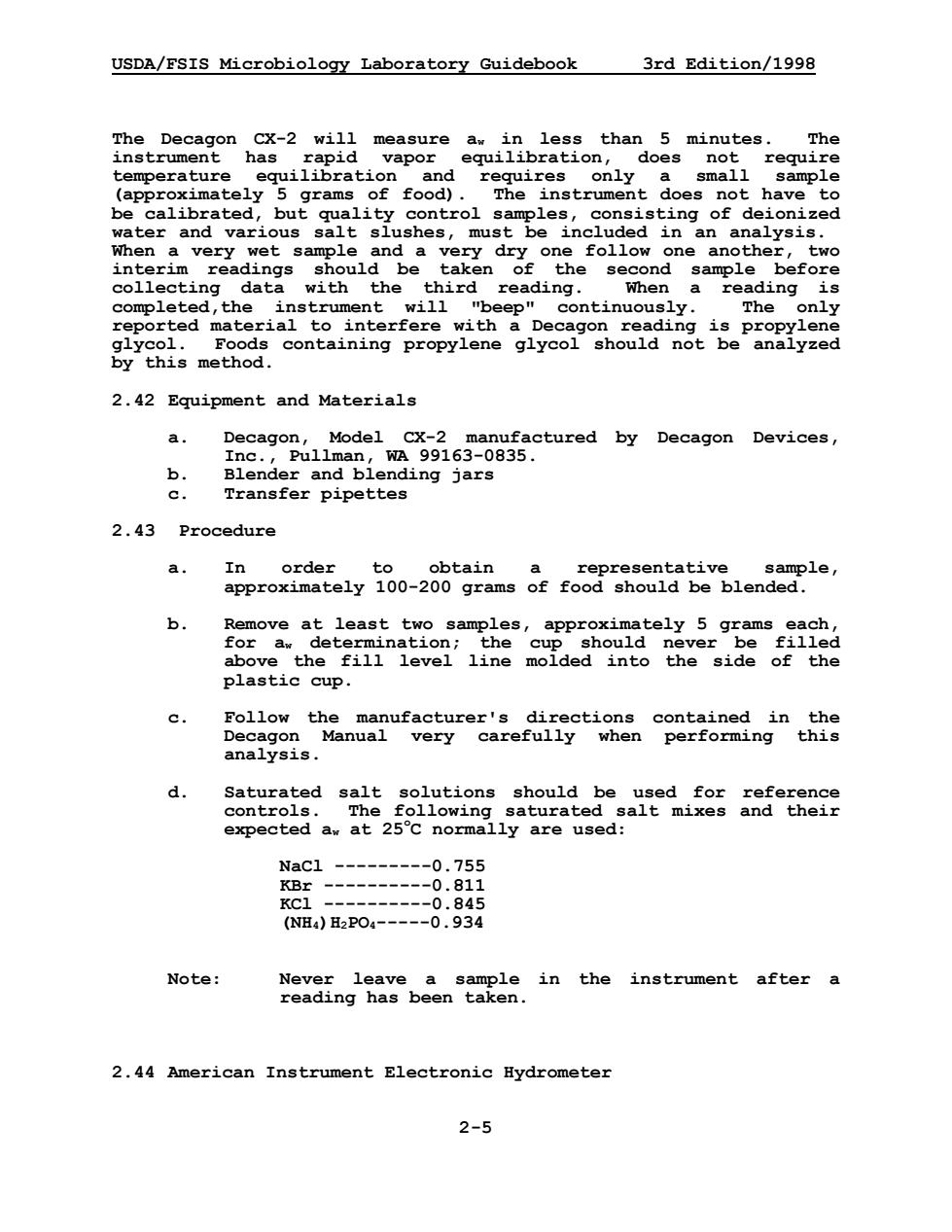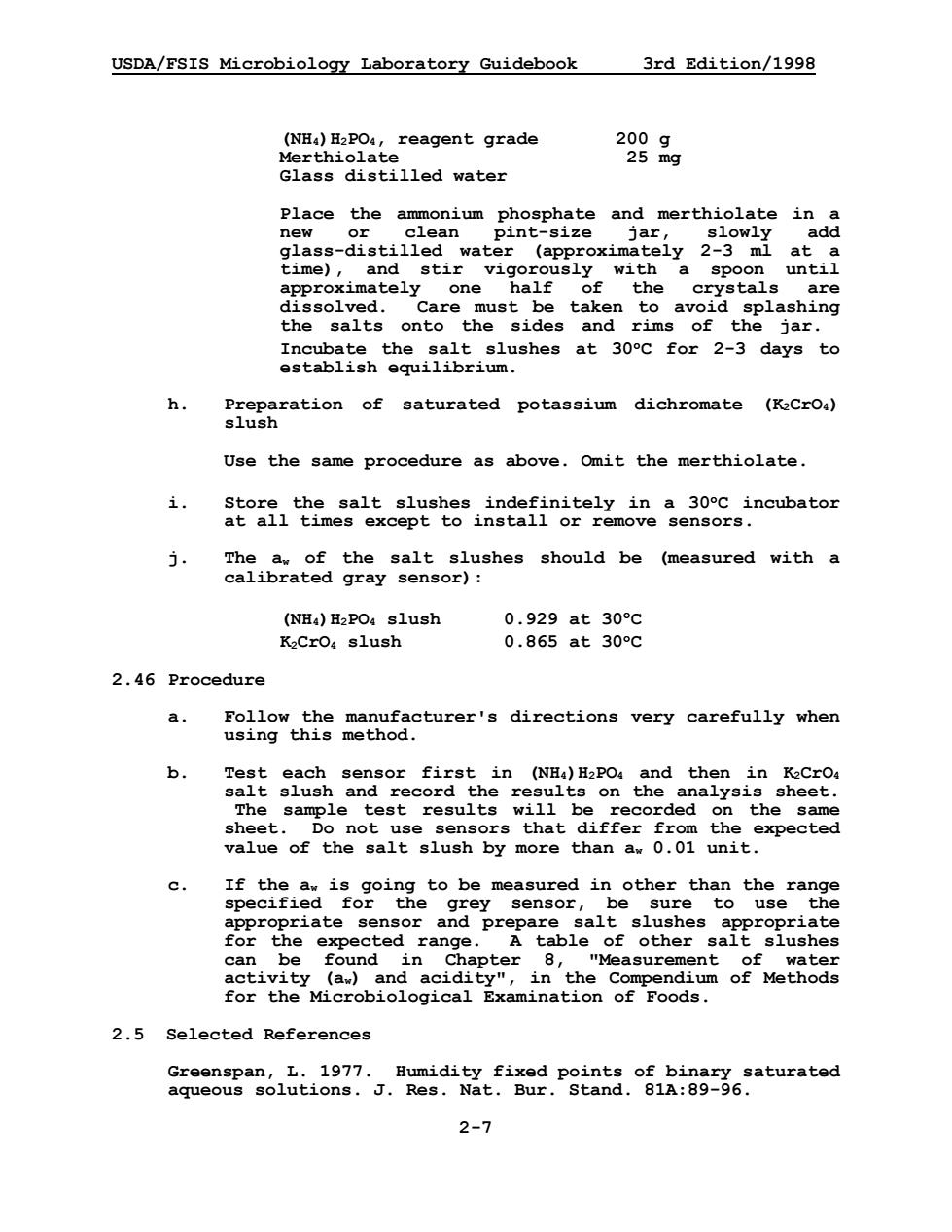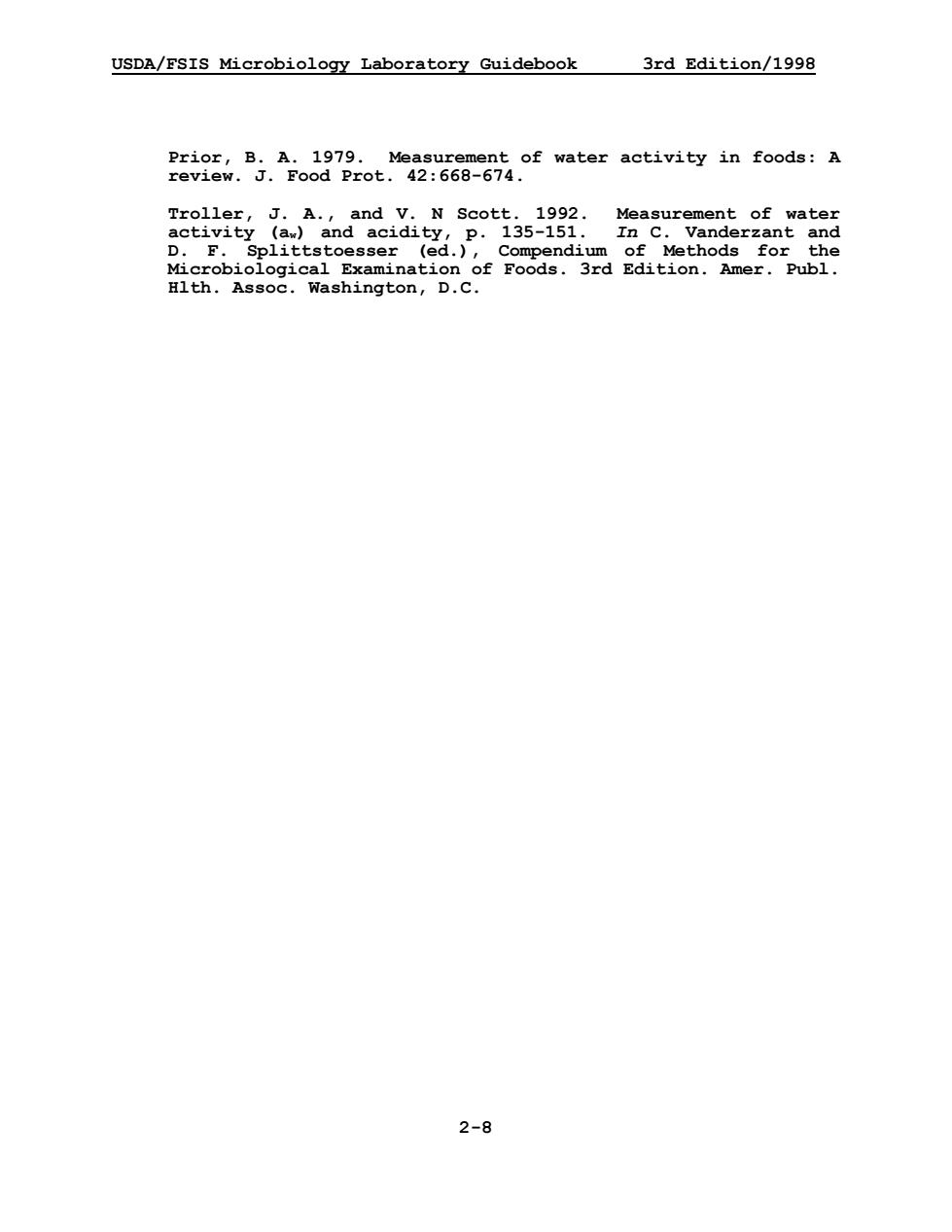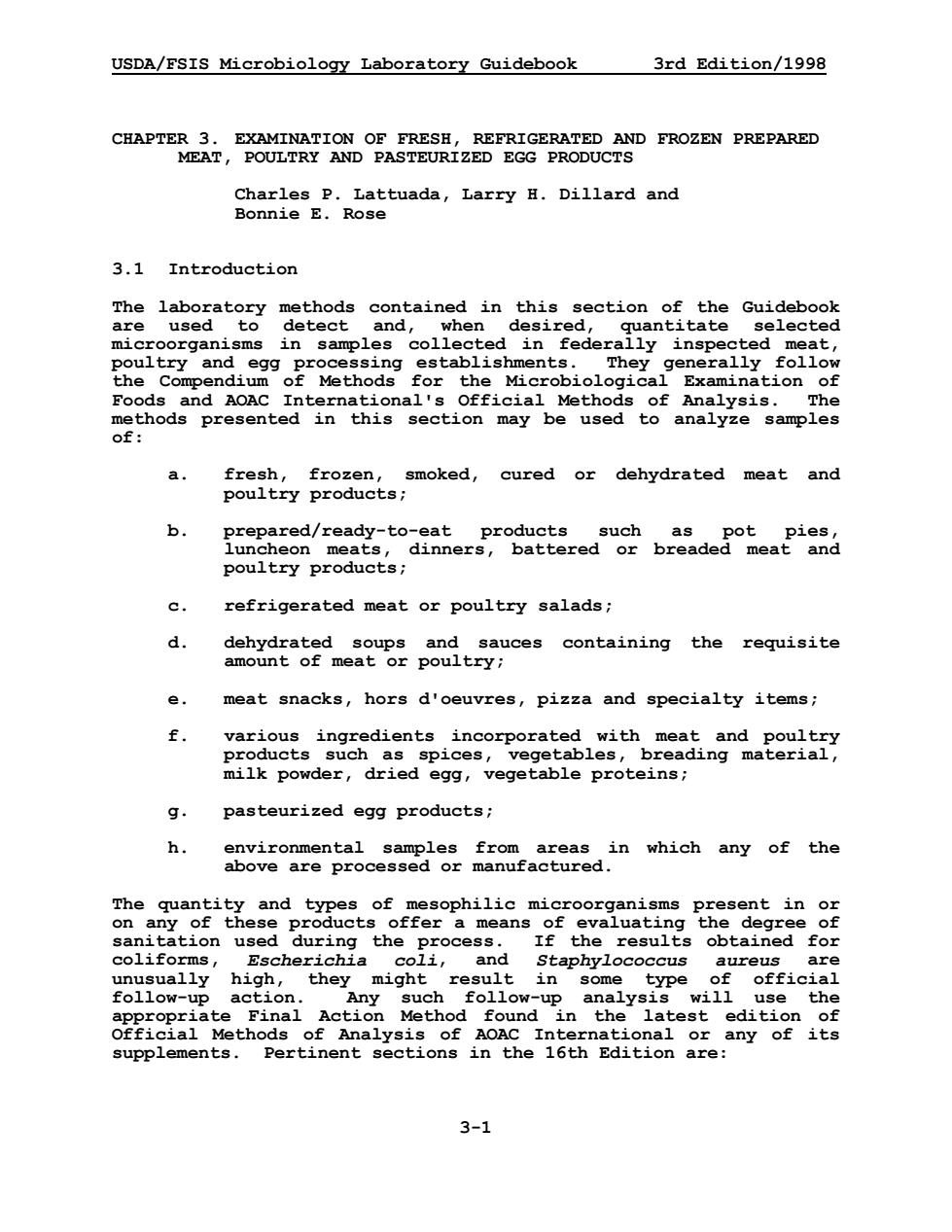
USDA/FSIS Microbiology Laboratory Guidebook 3rd Edition/1998 The Dec CX-2 will 】aa s than 5 minutes rapid equilibration, does not require temperature equilibration and requires only a smal sample gran of food) instrument es not nave analysis When a very wet sample and a very dry one follow one another, two interim readings be h taken of the second sample before co1 reading. a re ng 11 reported material to interfere with a Dec reading is pr glycol. Foods containing propylene glycol should not beanaiyzed by this method. 2.42 Equipment and Materials a. Decagon, Model CX-2 :99163- ctured by Decagon Devices. ng jar: Transfer pipettes 2.43 Procedure a. eco2nta1yt80-208tghaseogenateb1oenia1e, I b. ab the fill le rel line 8 the side。fd plastic cup. c. Follow the manufacturer's wher analysis. 8 Conarated salt soutionrratedat mi and thats cont expe a 25℃n9 NaC1-0.755 0.8 (NE4)H2PO4- -0034 Note: erdind a boon in the instrument after 2.44 American Instrument Electronic Hydrometer 2-5
USDA/FSIS Microbiology Laboratory Guidebook 3rd Edition/1998 2-5 The Decagon CX-2 will measure aw in less than 5 minutes. The instrument has rapid vapor equilibration, does not require temperature equilibration and requires only a small sample (approximately 5 grams of food). The instrument does not have to be calibrated, but quality control samples, consisting of deionized water and various salt slushes, must be included in an analysis. When a very wet sample and a very dry one follow one another, two interim readings should be taken of the second sample before collecting data with the third reading. When a reading is completed,the instrument will "beep" continuously. The only reported material to interfere with a Decagon reading is propylene glycol. Foods containing propylene glycol should not be analyzed by this method. 2.42 Equipment and Materials a. Decagon, Model CX-2 manufactured by Decagon Devices, Inc., Pullman, WA 99163-0835. b. Blender and blending jars c. Transfer pipettes 2.43 Procedure a. In order to obtain a representative sample, approximately 100-200 grams of food should be blended. b. Remove at least two samples, approximately 5 grams each, for aw determination; the cup should never be filled above the fill level line molded into the side of the plastic cup. c. Follow the manufacturer's directions contained in the Decagon Manual very carefully when performing this analysis. d. Saturated salt solutions should be used for reference controls. The following saturated salt mixes and their expected aw at 25o C normally are used: NaCl -0.755 KBr -0.811 KCl -0.845 (NH4)H2PO4-0.934 Note: Never leave a sample in the instrument after a reading has been taken. 2.44 American Instrument Electronic Hydrometer

USDA/FSIS Microbiology Laboratory Guidebook 3rd Edition/1998 Another method for determining ax is the American Instrument Electronic Hydrometer. Reportedly,it is an accurate instrument for e me the en F111 ts,provid the ues the char e in trical resistance of cially coated 82d8a,9eaeo9599 lithium chloride sensors. The electronic part of the instrument is special care mercury vapor unstable hydrocarbons such as ketones; and sulfur compounds such as hydrogen sulfide and sulfur Sensors can be affected reversibly by polar vapors such + er the polar vapors are removed by aeration. 2.45 Equipment and Materials Instrument Electronic Hydrometer (Model No 30-87 or equivalent)manufactured by Newport Scientific, D20 794 b m the abo Company makes different types of sensors for different ranges of humidities. This sensor is the one most uct ana alyses. They and comes ith t factory gray sensors poothonthat the readings 0.90-0.94be inside the linear correction factor of each sensor at 30C (86F)be into each calibration curve c lids normally fit into the rims of standard pint sige canning jars. The 8-gang switch box allows measurement The sensor d A forced-air incubator should be used to hold the ples at30±0.5C a 1 5"diameter hole in the incubator to introduce the electrical leads for the eight sensors into the incubator.Be sure to e with sealant e. f. Pipettes 9. Preparation ammonium phosphate 2-6
USDA/FSIS Microbiology Laboratory Guidebook 3rd Edition/1998 2-6 Another method for determining aw is the American Instrument Electronic Hydrometer. Reportedly, it is an accurate instrument for measurement of the aw in food products, provided the manufacturer's directions are followed carefully. The instrument measures the changes in electrical resistance of specially coated lithium chloride sensors. The electronic part of the instrument is very rugged and needs no special care. The sensors, like pH electrodes, are very sensitive and can be affected permanently by water condensation, desiccation, corrosive chemicals such as mercury vapor, unstable hydrocarbons such as ketones; halogen gases; and sulfur compounds such as hydrogen sulfide and sulfur dioxide. Sensors can be affected reversibly by polar vapors such as ammonia, amines, alcohols, glycols and glycerols. The response of sensors will return to normal, from slightly higher readings, if the polar vapors are removed by aeration. 2.45 Equipment and Materials a. American Instrument Electronic Hydrometer (Model No. 30-87 or equivalent) manufactured by Newport Scientific, Inc., 8246E Sandy Court, Jessup, MD 20794. b. Sensors, Color Code-Gray, (Cat-No. 4822W) for the above instrument, available from the same manufacturer. The Company makes different types of sensors for different ranges of humidities. This sensor is the one most commonly used in meat and poultry product analyses. They have an aw range of about 0.81 to 0.99. Each sensor is unique and comes with its own factory calibration curve. When purchasing gray sensors specify that the aw readings between 0.90 - 0.94 be inside the linear portion of the calibration curve. Also request that the correction factor of each sensor at 30°C (86°F) be incorporated into each calibration curve. c. Sensor lids and 8-gang switch box. These socket type lids normally fit into the rims of standard pint size canning jars. The 8-gang switch box allows measurement of eight samples at a time. The sensor connectors should be labeled 1 to 8 to correspond to the switch position. d. A forced-air incubator should be used to hold the samples at 30 ± 0.5°C. If necessary, cut a 1.5" diameter hole in the incubator to introduce the electrical leads for the eight sensors into the incubator. Be sure to fill the hole with sealant. e. Clean and dry standard pint-size glass canning jars, without chips or cracks on the rims, for the samples. f. Pipettes g. Preparation of a saturated ammonium phosphate, monobasic, [(NH4)H2PO4] slush

USDA/FSIS Microbiology Laboratory Guidebook 3rd Edition/1998 agen grade 2988g Glass distilled water Place the ammonium and glass-distilled water (approximately 2-3 mi at a time), and stir vigorously with a spoon until tely one crysta ashare e the a1十 slushes establish equilibrium. s at 30c for 2-3 days to h. Poparation of saturated potassium dichromate (KCrO) Use the same procedure as above.Omit the merthiolate i Store the salt slushes indefinitely in a 300c incubator at all times except to install or remove sensors. 5. should be (measured with a ensor): (NH)H2PO4 slush 0.929at30C K2CrO slush 0.865at30 2.46 Procedure a. Follow cturer's directions very carefully when b. Test each sensor first in (NE)H2PO and then in K2Cro salt slush and record ults on the analysis sheet. value of the salt slush by more than ax 0.01 unit. c. range propriate sensor and for the expected range. ED or OUe Sae can be found in hapter 8, "Measure 2.5 Selected References 2-7
USDA/FSIS Microbiology Laboratory Guidebook 3rd Edition/1998 2-7 (NH4)H2PO4, reagent grade 200 g Merthiolate 25 mg Glass distilled water Place the ammonium phosphate and merthiolate in a new or clean pint-size jar, slowly add glass-distilled water (approximately 2-3 ml at a time), and stir vigorously with a spoon until approximately one half of the crystals are dissolved. Care must be taken to avoid splashing the salts onto the sides and rims of the jar. Incubate the salt slushes at 30°C for 2-3 days to establish equilibrium. h. Preparation of saturated potassium dichromate (K2CrO4) slush Use the same procedure as above. Omit the merthiolate. i. Store the salt slushes indefinitely in a 30°C incubator at all times except to install or remove sensors. j. The aw of the salt slushes should be (measured with a calibrated gray sensor): (NH4)H2PO4 slush 0.929 at 30°C K2CrO4 slush 0.865 at 30°C 2.46 Procedure a. Follow the manufacturer's directions very carefully when using this method. b. Test each sensor first in (NH4)H2PO4 and then in K2CrO4 salt slush and record the results on the analysis sheet. The sample test results will be recorded on the same sheet. Do not use sensors that differ from the expected value of the salt slush by more than aw 0.01 unit. c. If the aw is going to be measured in other than the range specified for the grey sensor, be sure to use the appropriate sensor and prepare salt slushes appropriate for the expected range. A table of other salt slushes can be found in Chapter 8, "Measurement of water activity (aw) and acidity", in the Compendium of Methods for the Microbiological Examination of Foods. 2.5 Selected References Greenspan, L. 1977. Humidity fixed points of binary saturated aqueous solutions. J. Res. Nat. Bur. Stand. 81A:89-96

USDA/FSIS Microbiology Laboratory Guidebook 3rd Edition/1998 Prior,B.A.1979.Measurement of water activity in foods:A review.J.Food Prot.42:668-674. Troller.J.A. and V.N Scott.1992.Measurement of water activity (a)and acidity, p.135-151.In C.Vanderzant and HIth.Assoc 2-8
USDA/FSIS Microbiology Laboratory Guidebook 3rd Edition/1998 2-8 Prior, B. A. 1979. Measurement of water activity in foods: A review. J. Food Prot. 42:668-674. Troller, J. A., and V. N Scott. 1992. Measurement of water activity (aw) and acidity, p. 135-151. In C. Vanderzant and D. F. Splittstoesser (ed.), Compendium of Methods for the Microbiological Examination of Foods. 3rd Edition. Amer. Publ. Hlth. Assoc. Washington, D.C

USDA/FSIS Microbiology Laboratory Guidebook 3rd Edition/1998 CHAPTER 3. Examinatton of FRESH REFRIGERATED AND FROZEN PREPARED MEAT,POULTRY AND PASTEURIZED EGG PRODUCTS Charles Lattuada,Larry H.Dillard and 3.1 Introduction of the Guidebo desired, quantitate selected microorganisms in samples collected in federaily inspected meat, They genera ly follow 21 methods presented in this section may be used to analyze samples of: a. fresh b. R56odetoaaterogaEt8ea"ob2angoteaPad 0 refrigerated meat or poultry salads; g requisite e. meat snacks,hors d'oeuvres,pizza and specialty items; f. ing milk powder,dried egg,vegetable proteins; g. pasteurized egg products; h. environmental samples from areas in which any of the above are processed or manufactured. of ns sanitation used during the process. If the results obtained for coliforms, Escherichia coli,and Staphylococcus aureus are might pate Action Method foundin they latest edition Ogricial Methods of Analysis of AOAC International or any of its supplements.Pertinent sections in the 16th Edition are: 3-1
USDA/FSIS Microbiology Laboratory Guidebook 3rd Edition/1998 3-1 CHAPTER 3. EXAMINATION OF FRESH, REFRIGERATED AND FROZEN PREPARED MEAT, POULTRY AND PASTEURIZED EGG PRODUCTS Charles P. Lattuada, Larry H. Dillard and Bonnie E. Rose 3.1 Introduction The laboratory methods contained in this section of the Guidebook are used to detect and, when desired, quantitate selected microorganisms in samples collected in federally inspected meat, poultry and egg processing establishments. They generally follow the Compendium of Methods for the Microbiological Examination of Foods and AOAC International's Official Methods of Analysis. The methods presented in this section may be used to analyze samples of: a. fresh, frozen, smoked, cured or dehydrated meat and poultry products; b. prepared/ready-to-eat products such as pot pies, luncheon meats, dinners, battered or breaded meat and poultry products; c. refrigerated meat or poultry salads; d. dehydrated soups and sauces containing the requisite amount of meat or poultry; e. meat snacks, hors d'oeuvres, pizza and specialty items; f. various ingredients incorporated with meat and poultry products such as spices, vegetables, breading material, milk powder, dried egg, vegetable proteins; g. pasteurized egg products; h. environmental samples from areas in which any of the above are processed or manufactured. The quantity and types of mesophilic microorganisms present in or on any of these products offer a means of evaluating the degree of sanitation used during the process. If the results obtained for coliforms, Escherichia coli, and Staphylococcus aureus are unusually high, they might result in some type of official follow-up action. Any such follow-up analysis will use the appropriate Final Action Method found in the latest edition of Official Methods of Analysis of AOAC International or any of its supplements. Pertinent sections in the 16th Edition are: